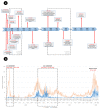Effect of Lockdowns on Hospital Staff in a COVID Center: A Retrospective Observational Study
- PMID: 36366356
- PMCID: PMC9698425
- DOI: 10.3390/vaccines10111847
Effect of Lockdowns on Hospital Staff in a COVID Center: A Retrospective Observational Study
Abstract
At the onset of the SARS-CoV-2 pandemic, individual and social measures were strengthened through restrictive non-pharmaceutical interventions, labelled with the term “lockdown”. In Italy, there were two lockdowns (9 March 2020−3 May 2020 and 3 November 2020−27 March 2021). As part of preventive measures, healthcare workers and the administrative staff population of Policlinico A. Gemelli underwent nasopharyngeal swab tests from 1 March 2020 to 9 February 2022, a long time interval that includes the two aforementioned lockdowns. The population included 8958 people from 1 March 2020 to 31 December 2020; 8981 people from 1 January 2021 to 31 December 2021; and 8981 people from 1 January 2022 to 9 February 2022. We then analysed pseudo-anonymized data, using a retrospective observational approach to evaluate the impact of the lockdown on the incidence of SARS-CoV-2 infections within the population. Given the 14 day contagious period, the swab positivity rate (SPR) among the staff decreased significantly at the end of the first lockdown, every day prior to 18 May 2020, by 0.093 (p < 0.0001, CI = (−0.138−−0.047)). After the fourteenth day post the end of the first lockdown (18 May 2020), the SPR increased daily at a rate of 0.024 (p < 0.0001, 95% CI = (0.013−0.034)). In addition, the SPR appeared to increase significantly every day prior to 17 November 2020 by 0.024 (p < 0.0001, CI = (0.013−0.034)). After the fourteenth day post the start of the second lockdown (17 November 2020), the SPR decreased daily at a rate of 0.039 (p < 0.0001, 95% CI = (−0.050−−0.027)). These data demonstrate that, in our Institution, the lockdowns helped to both protect healthcare workers and maintain adequate standards of care for COVID and non-COVID patients for the duration of the state of emergency in Italy.
Keywords: COVID-19; healthcare workers; lockdown; swab; vaccination.
Conflict of interest statement
The authors declare no conflict of interest.
Figures



References
-
- Olapeju B., Hendrickson Z.M., Rosen J.G., Shattuck D., Storey J.D., Krenn S., Shaivitz M., Serlemitsos E., Tseng T.-Y., Tsang S.W., et al. Trends in handwashing behaviours for COVID-19 prevention: Longitudinal evidence from online surveys in 10 sub-Saharan African countries. PLoS Glob. Public Health. 2021;1:e0000049. doi: 10.1371/journal.pgph.0000049. - DOI - PMC - PubMed
LinkOut - more resources
Full Text Sources
Research Materials
Miscellaneous

